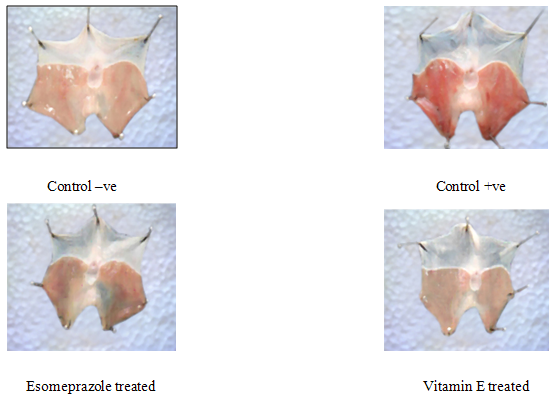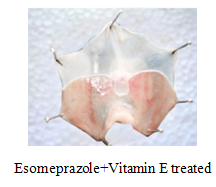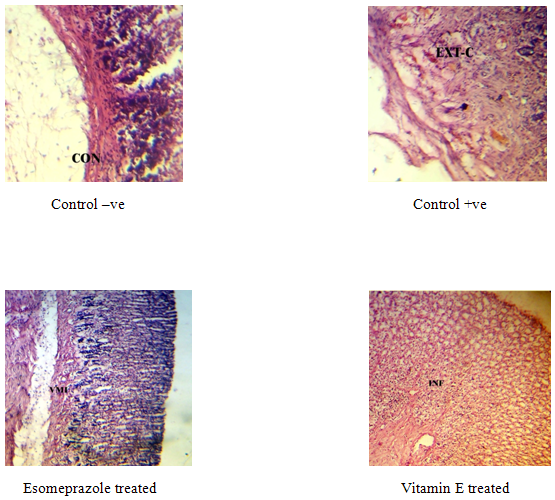 About Authors:
About Authors:
NITIN M, MOHAN REDDY U*
Department of Pharmacology,
H.K.E.S’s, Matoshree Taradevi Rampure Institute of Pharmaceutical Sciences,
Sedam Road, Gulbarga- 585 105, Karnataka
*mohanreddy.udumula@gmail.com
ABSTRACT
Gastric ulcer is one of the most prevalent gastrointestinal disorders, which affects approximately 5-10% of people during their life. The present study was aimed to find out the pharmacodynamic influence of vitamin E and esomeprazole and their combination on gastro intestinal parameters in pylorus ligation induced ulcers in rats in single and multiple dose studies. Various parameters were studied in pylorus ligation induced ulcer model viz. gastric volume, pH, total acidity, free acidity, and ulcer index.The antiulcer effect of the combination of vitamin E 0.9 mg/200 g and esomeprazole 0.54 mg/200 g b.w orally was compared with the reference standard esomeprazole 0.54 mg/200 g b.w orally. The ulcer index was calculated and other biochemical parameters of gastric juice were estimated. The ulcer index of combination showed significant (P < 0.05) reduction while other biochemical parameters like volume, pH, free acidity and total acidity of gastric juice showed highly significant (P < 0.001) reduction when compared to control and standard esomeprazole.
Reference Id: PHARMATUTOR-ART-1358
INTRODUCTION
Peptic ulcer disease is one of the most common gastrointestinal disorders, which causes a high rate of morbidity particularly in the population of non-industrialized countries1. Peptic ulcer disease occurs mainly due to consumption of NSAIDs, infection by H. pylori, stress or due to pathological condition such as Zollinger- Ellison Syndrome.Peptic ulcer may occur due to an imbalance between offensive and defensive factor. Major offensive factors are acid, pepsin, Helicobacter pylori and bile salts. Defensive factors mainly involve mucus-bicarbonate secretion and prostaglandins2. Among the various causes of gastric ulceration reactive oxygen species (ROS) plays an important role in the pathogenesis of a wide variety of clinical disorders and gastric damage. They attack essential cell constituents, such as proteins, lipids and nucleic acids, leading to the formation of toxic compounds. Besides ROS the other fundamental factor in the pathogenesis is the hypersecretion of gastric acid. Therefore, the control of acid secretion and neutralization of ROS may be essential for the treatment of peptic ulcer. This can be done by combination therapy of antioxidants with antisecretory drugs like esomeprazole.
One of the main cause of peptic ulcer can be H. pylori bacterial infection; however some ulcers are caused by the long-term use of nonsteroidal anti-inflammatory agents (NSAIDs), like aspirin and ibuprofen, and because of stress due to socio-economic problems, etc. In a few cases, cancerous tumours in the stomach or pancreas also cause peptic ulcers3. Free radicals are unpaired electrons released during oxidative stress and play important role in pathogenesis of peptic ulcer as they cause cellular damage. Antioxidants are used to neutralize these free radicals which function by accepting or donating an electron to eliminate the unpaired electron4.
Esomeprazole is a new proton pump inhibitor and is the S-isomer of racemic omeprazole.The oral bioavailability of esomeprazole is approximately 89% with a dose of 40 mg, and the half-life is approximately 1.5 hours.Esomeprazole is a safe and effective proton pump inhibitor. It is effective in the treatment of peptic ulcer disease and gastroesophageal reflux disease5.Vitamin-E iswell known antioxidant that defends against cell damage.
Hence an attempt was being made to study the efficacy of combination of the same antioxidant ( Vit-E) with esomeprazole to treat peptic ulcers.
MATERIALS AND METHODS
Drugs
Pure drug samples of esomeprazole and vitamin E were procured from Aurobindo Pharmaceuticals (Hyderabad) and Cipla pharmaceuticals (Mumbai) as gift samples. The dose calculations were extension of human dose based on body surface area6.
Experimental Animals
Albino rats (Wistar strain) of either sex weighing 180-250 g were used for the study. They were procured from central animal house, M.R.Medical College, Gulbarga. They were kept in the departmental animal house at 26 ± 2°C relative humidity 55 ± 15%, in light and dark cycles of 12 and 12 h, respectively for 10 days before and during the experiments. Animals were provided with standard rodent pellet diet (Golden feeds, Delhi) with water ad libitum. The experimental protocol was approved by the Institutional Animal Ethical Committee (IAEC) (HKE COP / IAEC / 35 / 2010 -11/CPASEA).
Evaluation of anti -ulcer activity
One animal model (Pyloric ligation) was employed to evaluate the Anti-ulcer activity of Vitamin E and esomeprazole and their combination in single and multiple dose studies.
1) Pyloric ligation model7
In pylorus ligation induced ulcer model, the rats were divided into 4 groups of 6 animals each. The animals of Group I were treated with vehicle and the animals of Group II were treated with standard, i.e., esomeprazole 0.54 mg/200 g b.w orally. The animals of Group III were treated with vitamin E 0.9 mg per 200 g b.w orally. Group lV were treated with esomeprazole and vitamin E i.e., 0.54 mg and 0.9 mg per 200 g b.w orally with an interval of 30 min between them.
NOW YOU CAN ALSO PUBLISH YOUR ARTICLE ONLINE.
SUBMIT YOUR ARTICLE/PROJECT AT articles@pharmatutor.org
Subscribe to PharmaTutor Alerts by Email
FIND OUT MORE ARTICLES AT OUR DATABASE
Single dose studies
The rats were fasted for 24 h prior to the experiment with water ad libitum. During experimentation water also was withdrawn. At the end of 24 h, the rats were administered with drugs. Abdomen was opened by a midline incision. The stomach was lifted out and a ligature was placed at the pyloric sphincter without causing any damage to its blood supply. The stomach was replaced carefully and abdomen wall was sutured in two layers. After 6 h, the rats were sacrificed with excess of anesthetic ether, and the stomachs were dissected out. Gastric juice was collected and drained into test tubes and then centrifuged at 1000 rpm for 10 min8. and the volume of supernatant was noted. The pH of the gastric juice was recorded by pH meter. Then the contents were subjected for the analysis of free and total acidity. The stomachs were opened along the greater curvature then washed under running water to see for ulcers in the glandular portion of the stomach. The number of ulcers per stomach was noted and scoring was done microscopically with the help of hand lens (10x) (Kulkarni S.K, 2005).
Multiple dose studies
The drugs were administered daily for 5 days. On 5th day, the rats were fasted for 24 h before pyloric ligation.Care was being taken to avoid coprophagy.At the end of 24 h, the rats were anaesthetized with anesthetic ether. Abdomen was opened by a midline incision. The stomach was lifted out and a ligature was placed at the pyloric sphincter without causing any damage to its blood supply. The stomach was replaced carefully and abdomen wall was sutured in two layers as described above. After 6 h, the rats were sacrificed with excess of anesthetic ether, and the stomachs were dissected out. Gastric juice was collected and drained into test tubes and then centrifuged at 1000 rpm for 10 min. and the volume of supernatant was noted. The pH of the gastric juice was recorded by pH meter. Then the contents were subjected for the analysis of free and total acidity. The stomachs were opened along the greater curvature then washed under running water to see for ulcers in the glandularportion of the stomach. The number of ulcers per stomach was noted and scoring was done microscopically with the help of hand lens (10x) as described below, (Kulkarni S.K, 2005).
Scoring of ulcer9
0 = Normal coloured stomach
0.5 = Red colouration
1 = Spot ulcer
1.5 = Haemorrhagic streaks
2 = Ulcers ≥ 3 but ≤ 5
3 = Ulcers >5
Calculation of ulcer Index10
U1 = UN + US + UP x 10-1
U1 = Ulcer Index
UN = Average of number of ulcer per animal
US = Average of severity score
UP = Percentage of animal with ulcer
Determination of pH
An aliquot of 1ml gastric juice was diluted with 1ml of distilled water and pH of the solution was measured using pH meter.
Determination of total acidity11
An aliquot of 1ml gastric juice diluted with 1ml of distilled water was taken into a 50 ml conical flask and two drops of phenolphthalein and topfer reagent indicators was added to it and titrated with 0.01N NaOH until a permanent pink colour was observed. The volume of 0.01N NaOH consumed was noted. The total acidity is expressed as mEq/L by the following formula:
Acidity = Vol. of NaOH × N × 100 mEq/L
0.1
Determination of free acidity
Aliquot of gastric juice was titrated with 0.01N NaOH until canary yellow colour was observed. The volume of 0.01N NaOH consumed was noted. The free acidity was calculated by the same formula as for the determination of total acidity.
Determination of percentage protection
Control mean ulcer index – test mean ulcer index
%Protection= ----------------------------------------------------X 100
Control mean ulcer index
STATISTICAL SIGNIFICANCE
The results are expressed as the mean ± SD for each group. Statistical differences were evaluated using One-way analysis of variance (ANOVA) followed by Dunnet's t-test. Results were considered to be statistically significant at P<0.05.
RESULTS
Single dose studies
In pyloric ligation induced ulcer model, the percentage protection of combination group was found to be 82% when compared to control and standard esomeprazole alone (80%).
Multiple dose studies
In pyloric ligation induced ulcer model, the percentage protection of combination group was found to be 91.4% when compared to control and standard esomeprazole alone (82.2%).
DISCUSSION
Ulcer is a recurrent disease affecting large populations in all geographical regions, and reactive oxygen species have been implicated in the pathogenesis of a wide variety of clinical disorders and gastric damage. Peptic ulcers result from an imbalance between defensive (cytoprotectve) and offensive factors (gastric acid), association with Helicobacter pylori infection and increased use of NSAIDs like aspirin and indomethacin12,causing damage by inhibiting the biosynthesis of cytoprotectve prostaglandins13.
The Shay model of pylorus ligation is a simple, reproducible and highly predictable model for the screening and evaluation of antiulcer drugs. It utilizes neither the exogenous ulcerogens nor the induced exogenous interfering factors. In this model gastric ulceration may be due to increased secretion of acid pepsin which leads to auto digestion of gastric mucosa, decreased mucosal blood flow and breakdown of mucosal14 barriers. In addition pyloric ligation may reduce glutathione15 levels of gastric mucosa and increase the lipid peroxidation. The literature survey indicates that pepsin is active in lower pH. Therefore the reduced gastric ulcer in this model may occur due to the reduction in acid secretion and increased gastric pH. In this condition the activity of pepsin is minimized and consequently the digestion of mucosal barrier is prevented. In the present study, from (Table 1 and 2) the significant reduction in ulcer index and other biochemical parameters of gastric juice like volume, free acidity, total acidity and increase in pH by combination group suggests that its cytoprotectve mechanism may be due to inhibition of gastric secretion and neutralization of reactive oxygen species by one or more mechanisms. Esomeprazole, being a potent proton pump inhibitor, decreases the excess acid secretion, by irreversibly blocking the H , K -ATPase of the parietal cells. Vitamin E, being an antioxidant neutralizes all the free radicals, nitrates, nitrites that cause cellular damage.
Histopathological examination using haematoxylene and eosin staining (H & E) also revealed the protective activity of vitamin E & esomeprazole+vitamin E when compared to control and standard esomeprazole.
CONCLUSION
From the present study and available results, it can be concluded that the combination group of vitamin E and esomeprazole was found to be synergistic in nature in both single and multiple dose studies.
ACKNOWLEDGEMENTS
Authors are thankful to the authorities of H.K.E.society and Matoshree Taradevi Rampure Institute of Pharmaceutical Sciences, Gulbarga for providing facilities to carry out this study. We are grateful to Aurobindo Pharmaceuticals (Hyderabad) and Cipla pharmaceuticals (Mumbai) for providing the gift samples of vitamin E and esomeprazole respectively.
NOW YOU CAN ALSO PUBLISH YOUR ARTICLE ONLINE.
SUBMIT YOUR ARTICLE/PROJECT AT articles@pharmatutor.org
Subscribe to PharmaTutor Alerts by Email
FIND OUT MORE ARTICLES AT OUR DATABASE
REFERENCES:
1. Falk GW. Cecil essentials of medicine. Edn 5, Edinburgh:WBSaunders Company, 2001; pp. 334-343.
2. Mohammed A, Ravi Kumar J, Santosh H.Y.and Nagashruthi M.H. Antiulceractivity of anisochilus carnosus leaf extracts in pylorus ligation rats. IndianDrugs 45 (12): 979. (2008).
3. Shemerovskii KA and Nikul'shina SA (1998). Myoelectric activity of the rabbit stomach and duodenum following neurogenic and humoral effects. Ross Fiziol Zh Im I M Sechenova (Russian); 84(9): 931-939.
4. Dr Dhrubo Jyoti Sen. Herbal Antioxidants: A Great Hope for future. Pharma Times. 2008;40(12): 22-36.
5. Kale- Pradhan PB, Landry HK, Sypula WT. Esomeprazole for acid peptic disorders. Ann Pharmacother. 2002 Apr;36(4):655-63.
6. Laurence DR, Bacharach AL. Evaluation of drug activities and pharmacometrics. London and New York. Academic press; 1:160-61.
7. Shay M, Komarov SA, Fels D, Meranze D, Gruenstein H and Siplet. A simple method for uniform production of gastric ulceration in rat. Gastroenterology 1945; 5:43-61.
8. Nitin M, Prasad K, Girish M. Influence of Vitamin C with Lansoprazole in Pylorus Ligation Induced UlcerModel in Rats. RGUHS Journal of Pharmaceutical Sciences 2011;1(2):127-130.
9. S.K. Kulkarni. Hand book of experimental Pharmacology, Vallabh Prakashan New Delhi, 2002 pp. 149-150.
10. H.Gerhard Vogel. Drug Discovery and Evaluation, Springer-Verlag Berlin Heidelberg, New Your 2002 pp. 868.
11. Raju. D., Ilango. K., Chitra. V., Ashish. K.Evaluation of Antiulcer activity ofmethanolic extract of Terminalia Chebulafruits in experimental rats.Journal of Pharmaceutical Sciences and research1(3):101-107 (2009).
12. Grover JK, Vats V. Proton pump inhibitors. Trop Gastroenterol 1999;20:16-28.
13. Rainsford KD. The effect of 5-lipoxygenase inhibitors and leukotrien antagonists on the development of gastric lesion by non steroidal anti-inflammatory drugs in mice. Agents Actions 1987; 21:316-9.
14. Goel RK and Bhattacharya SJL. Gastroduodenal mucosal defense and mucosal protective agents. Indian J Exp Bio 1991; 29:701-14.
15. Mahendran P, Sabitha KE, Shyamaladevi CV. Prevention of HClethanol induced gastric mucosal injury in rats by Garcinia cambogia extract and its possible mechanism of action. J Expl Biol 2002:58-62.
Table no.1: Influence of vitamin E and esomeprazole and their combination in pylorus ligated rats in single dose studies
|
Gr.no |
Treatment |
Vol of juice |
pH |
Free acidity |
Total acidity |
Ulcer index |
%Protection |
|
1 |
Control |
2.800 ± 0.11 |
1.700 ± 0.30 |
38.67 ± 1.76 |
47.00 ± 1.52 |
2.167 ± 0.16 |
_ |
|
2 |
Vitamin E |
2.033 ± 0.08 |
5.167 ± 0.16 |
23.67 ± 0.88 |
35.00 ± 0.57 |
0.833 ± 0.33 |
70 % |
|
3 |
Esomeprazole |
1.600 ± 0.11 |
4.833 ± 0.12 |
16.67 ± 066 |
33.67 ± 0.88 |
0.333 ± 0.16 |
80 % |
|
4 |
Esomeprazole + vit E |
2.267 ± 0.17 |
5.967 ± 0.03 |
32.17 ± 1.30 |
35.67 ± 2.02 |
0.666 ± 0.44 |
82 % |
Values are the mean S.E.M. of 6 rats / treatment.
Significant *P < 0.05 compared with standard esomeprazole.
Table no.2: Influence of vitamin E and esomeprazole and their combination in pylorus ligated rats in multiple dose studies
|
Gr.no |
Treatment |
Vol of juice |
pH |
Free acidity |
Total acidity |
Ulcer index |
%Protection |
|
1 |
Control |
8.133 ± 0.11 |
1.800 ± 0.07 |
112.0 ± 0.73 |
124.3 ± 0.55 |
5.833 ± 0.10 |
_ |
|
2 |
Vitamin E |
4.567 ± 0.14 |
6.767 ± 0.09 |
56.67 ± 0.55 |
67.67 ± 0.55 |
1.000± 0.18 |
75% |
|
3 |
Esomeprazole |
2.467 ± 0.15*** |
7.467 ± 0.11*** |
34.00 ± 1.31*** |
44.00 ± 0.96*** |
0.333 ± 0.10* |
94.3% |
|
4 |
Esomeprazole + vit E |
3.200 ± 0.07*** |
7.133 ± 0.11* |
40.00 ± 0.73*** |
49.67 ± 1.17*** |
0.500 ± 0.18 |
91.4% |
Values are the mean S.E.M. of 6 rats / treatmentSignificant ***P < 0.001 compared with standard esomeprazole
Figure. no1:Stomach epithelium of albino rats in pylorus ligation induced ulcer model:


Figure. no 2: Histopathological studies of pylorus ligation induced ulcer model in rat:
Control negative (-ve):
Gastric mucosa shows normal histology.
Control positive (+ve):
Gastric mucosa shows extensive ulceration, congestion and extensive inflammation.
Standard Esomeprazole:
Gastric mucosa appearing normal very few inflammatory cells seen.
Vitamin E:
Gastric mucosa shows inflammation
Esomeprazole + Vitamin E:
Gastric mucosa shows no congestion, no ulceration and very mild inflammation.


NOW YOU CAN ALSO PUBLISH YOUR ARTICLE ONLINE.
SUBMIT YOUR ARTICLE/PROJECT AT articles@pharmatutor.org
Subscribe to PharmaTutor Alerts by Email
FIND OUT MORE ARTICLES AT OUR DATABASE











.png)

